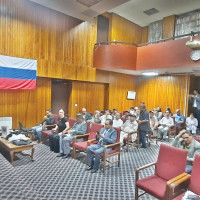- Saturday, 25 October 2025
Spring Skies And Cosmic Wonders
The night skies of this warm spring month could invite enthusiastic stargazers to watch the wonders of our glorious heavens bejewelled with stars, planets, constellations and many enigmatic entities. Planet Mercury would not be noticeable this month before sunup in the eastern sky in the constellation Pisces (fishes) due to its proximity to the Sun. Planet Venus would be venturing to be visible very succinctly before dawn in the comely constellation Pisces to the left of the confounding circlet asterism.
The ruddy planet Mars would be marvellously present in the southwestern sky after sunset. It would be sinking slowly towards the horizon and be evanescent by midnight. Mars would be merrily marching through the congenial constellations Gemini (twins) and Cancer (crab). Stars Castor (Kasturi) and Pollux (Punarbasu) scintillate in constellation Gemini above Mars. The orange-hued star Pollux is puzzlingly 34 light-years away. Castor is sparsely 52 light-years away. The Baffling Beehive cluster would be beckoning bewitchingly in the constellation Cancer below Mars. Consisting credibly of one thousand shiny stars, this open star cluster termed Praesepe (manger) is estimated to be conceivably 577 light-years away.
The huge planet Jupiter and its numerous moons can be appreciated in the western sky shortly after dusk. It would be joyfully mingling with the stars in the compact constellation Taurus (bull). The alluring red giant star Aldebaran (Rohini) could be spotted below Jupiter. It is perhaps 65 light-years away. Ringed planet Saturn and far-flung blue planet Neptune would be lost in the sun’s glare. They would be moving through the constellations Aquarius (water bearer) and the sprawling constellation Pisces. Planet Uranus could be glimpsed as a lambent light speck in the western sky in Taurus after nightfall till the first week of the month. It would be unseen then.
The full moon befalls on 13 April, while the new moon would betide on 27 April (venerated mothers’ day). The full moon is popularly tagged as the pink full moon because it marks the appearance of moss pink or wild ground phlox, which is one of the first spring flowers. Chaite Dashain is revered respectfully on 05 April. Ram Navami is celebrated cheerfully on 06 April. Nepali New Year BS 2082 is welcomed wholeheartedly on 14 April. The Lyrid meteor shower would display a meagre 20 meteors per hour at its peak that would be witnessed on the night of the 22nd till the morning of the 23rd of April. It is produced by particles left behind by comet Thatcher.
The shower runs annually from 16-25 April. These meteors can exhibit bright dust trails that last for several seconds. The thin crescent moon will not hamper the good show of streaking shooting stars. They could be relished mostly from tenebrous sites after midnight. Alfred Thatcher from New York City disclosed this comet, currently tagged as C/1861 G1 (Thatcher), in 1861. It hurtles around the Sun once in about 417 years. As Earth ploughs through the comet’s debris remnants, Lyrids could be enjoyed.
They seemingly exude from the radiant that lies in the vicinity of the shimmering star Vega (Avijit) residing in the cute constellation Lyra (harp) in the northeastern sky. From the northern part of the globe, hypnotic Vega climbs upwards through the night. Before dawn, Vega would be aloft overhead. Comet Thatcher returns in 2278. The Lyrid meteor shower has been allegedly recorded by Chinese astronomers in the year 687 BCE, when Lyrids fell fearfully like rain.
At that time, ancient China had corresponded with the Spring and Autumn period (771 to 476 BCE), with a traditional association with the iconic Chinese teacher and philosopher Confucius some 2700 years back. Vega is actually 25 light-years away. With the stars Deneb in constellation Cygnus (swan or nicknamed Northern Cross) and Altair (Sravana) in constellation Aquila (eagle), Vega would draw an imaginary asterism distinguished as the Summer Triangle. Because the earth's axis wobbles, the North Pole gradually shifts and points to different stars over a 26,000-year cycle. Vega was the northern pole star around 12,000 BCE and will be so again in the year 13727, eventually replacing peculiar Polaris (Dhruba Tara), which has forged into a terrific triple star system oddly 433 light-years away.
It sits serenely in the constellation Ursa Minor (little bear). Dazzling supergiant star Deneb (dubbed the tail of the bird in Arabic) is a queer 2600 light-years away. Perplexingly pirouetting star Altair is exiguously 16.7 light-years away. The race between Jupiter and Saturn for hosting the most moons in the Solar System has finally halted for now. Awesomely, 128 previously unknown moons scooting around Saturn have been ascertained by astronomers and officially recognised by the International Astronomical Union (IAU).
Therefore, planet Saturn can proudly boast of its copious moons, totalling a whopping 274, leaving the planet Jupiter behind in second place with its just 95 mystique moons. They are not Earth's moon alike and thus not pleasantly large and pleasingly spherical. They are minute irregular moonlets, mostly blobby and potato-shaped, with a few kilometres across in dimension. Experts argue that they were small groups captured by gravity in Saturn's orbit. Subsequent collisions would have smashed them to rocky moonlets, which must have transpired utterly 100 million years ago (deemed as a brief eye-blink of time for planets).
Its mammoth moon Titan is bigger than planet Mercury, while the minuscule elongated moon Aegaeon would mimic a moderate sports stadium. NASA’s next-generation space telescope, the Spectro-Photometer for the History of the Universe, Epoch of Reionisation, and Ices Explorer (SPHEREx), developed with participation from the Korea Astronomy and Space Science Institute (KASI), was sent off into space. It lifted off from California’s Vandenberg Space Force Base aboard SpaceX’s Falcon 9 rocket. SPHEREx would scan the entire sky with the ambitious goal of creating the world’s first infrared 3D cosmic map.
This programme will expand the frontiers of astronomy by identifying celestial bodies that possess water and ice and uncover secrets on the origins of the universe. By studying the distribution of galaxies, the erudite professionals hope to unravel reasons behind the universe’s rapid expansion following the Big Bang occurring 14 billion years ago. NASA’s James Webb Space Telescope (JWST) specialises in infrared observations. It would take detailed images of narrow regions, covering barely 1 per cent of the universe. In contrast, SPHEREx surveys the sky extensively.
After completing its initial operational phase, the telescope will spend a mere 25 months gathering over 600 pictures per day, ultimately compiling 3D maps containing data on approximately one billion Elysian objects. SPHEREx was selected as USD 242 million NASA exploratory project. It is led by the California Institute of Technology (Caltech) in collaboration with 12 companies, including NASA’s Jet Propulsion Laboratory (JPL). KASI is the only non-US institution involved in the mission. KASI designed a cryogenic vacuum chamber capable of simulating the extreme space environment at minus 220 degrees Celsius.
It developed software that processed the acquired information. The infrared 3D cosmic map and all-sky spectral catalogue will offer vital clues for understanding the formation and evolution of the universe and bestow avid astronomers' invaluable resources for delving into and cognising the cosmos deeply and comprehensively with meticulous ardency.
Grotesquely gigantic asteroid 2014 TN17 whizzed past Earth safely very recently with the striking speed of bizarrely 77.82 thousand kilometres per hour. It is nominally 165 metres wide (almost mirroring the Egyptian pyramid or double the size of the magnificent Taj Mahal). Detected eleven years ago in the arcane asteroid belt between planets Mars and Jupiter, asteroid 2014 TN17 tumbles around the Sun in an elliptical track (not perfectly circular) once in a scant 3.39 years.
Classified as a potentially hazardous asteroid (PHA), it zoomed by Earth from a desired distance of simply five million kilometres (over 13 times farther away from Earth than the moon) this time. However, it could alter its trajectory and hit Earth (nightmare scenario) with catastrophic consequences. To prevent such disasters, the Centre for Near-Earth Object Studies (CNEOS) of NASA and other competent space organisations worldwide chase, follow and ferret out rigorously and seriously these rogue asteroids like 2014 TN17 around the clock with constant monitoring for triggering alarms or alerting early warnings for knocking them out and averting impending dangers elegantly and successfully. Any possible harm or threat to humanity on earth could be hence warded off.
(Dr. Shah is an academician at NAST and patron of NASO.)

















